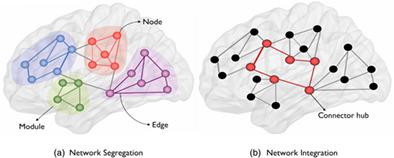当前位置:
X-MOL 学术
›
Hum. Brain Mapp.
›
论文详情
Our official English website, www.x-mol.net, welcomes your
feedback! (Note: you will need to create a separate account there.)
Graph-theoretical analysis of EEG functional connectivity during balance perturbation in traumatic brain injury: A pilot study
Human Brain Mapping ( IF 3.5 ) Pub Date : 2021-07-26 , DOI: 10.1002/hbm.25554 Vikram Shenoy Handiru 1, 2 , Alaleh Alivar 1, 2 , Armand Hoxha 1 , Soha Saleh 1, 2 , Easter S Suviseshamuthu 1, 2 , Guang H Yue 1, 2 , Didier Allexandre 1, 2
Human Brain Mapping ( IF 3.5 ) Pub Date : 2021-07-26 , DOI: 10.1002/hbm.25554 Vikram Shenoy Handiru 1, 2 , Alaleh Alivar 1, 2 , Armand Hoxha 1 , Soha Saleh 1, 2 , Easter S Suviseshamuthu 1, 2 , Guang H Yue 1, 2 , Didier Allexandre 1, 2
Affiliation

|
Traumatic brain injury (TBI) often results in balance impairment, increasing the risk of falls, and the chances of further injuries. However, the underlying neural mechanisms of postural control after TBI are not well understood. To this end, we conducted a pilot study to explore the neural mechanisms of unpredictable balance perturbations in 17 chronic TBI participants and 15 matched healthy controls (HC) using the EEG, MRI, and diffusion tensor imaging (DTI) data. As quantitative measures of the functional integration and segregation of the brain networks during the postural task, we computed the global graph-theoretic network measures (global efficiency and modularity) of brain functional connectivity derived from source-space EEG in different frequency bands. We observed that the TBI group showed a lower balance performance as measured by the center of pressure displacement during the task, and the Berg Balance Scale (BBS). They also showed reduced brain activation and connectivity during the balance task. Furthermore, the decrease in brain network segregation in alpha-band from baseline to task was smaller in TBI than HC. The DTI findings revealed widespread structural damage. In terms of the neural correlates, we observed a distinct role played by different frequency bands: theta-band modularity during the task was negatively correlated with the BBS in the TBI group; lower beta-band network connectivity was associated with the reduction in white matter structural integrity. Our future studies will focus on how postural training will modulate the functional brain networks in TBI.
中文翻译:

创伤性脑损伤平衡扰动期间脑电图功能连接的图论分析:一项初步研究
创伤性脑损伤 (TBI) 通常会导致平衡障碍,增加跌倒的风险和进一步受伤的机会。然而,TBI 后姿势控制的潜在神经机制尚不清楚。为此,我们使用 EEG、MRI 和弥散张量成像 (DTI) 数据进行了一项试点研究,以探索 17 名慢性 TBI 参与者和 15 名匹配的健康对照 (HC) 不可预测的平衡扰动的神经机制。作为姿势任务期间大脑网络功能整合和分离的定量测量,我们计算了来自不同频带的源空间 EEG 的大脑功能连接的全局图论网络测量(全局效率和模块化)。我们观察到 TBI 组在任务期间通过压力位移中心和 Berg 平衡量表 (BBS) 测量显示出较低的平衡性能。他们还表现出在平衡任务期间大脑激活和连接性降低。此外,在 TBI 中,从基线到任务的 alpha 波段的脑网络分离减少比 HC 小。DTI 的调查结果揭示了广泛的结构性损伤。在神经相关性方面,我们观察到不同频带所起的不同作用:任务期间的 theta 频带模块性与 TBI 组中的 BBS 呈负相关;较低的 β 波段网络连接与白质结构完整性的降低有关。我们未来的研究将集中在姿势训练如何调节 TBI 中的功能性大脑网络。
更新日期:2021-09-02
中文翻译:

创伤性脑损伤平衡扰动期间脑电图功能连接的图论分析:一项初步研究
创伤性脑损伤 (TBI) 通常会导致平衡障碍,增加跌倒的风险和进一步受伤的机会。然而,TBI 后姿势控制的潜在神经机制尚不清楚。为此,我们使用 EEG、MRI 和弥散张量成像 (DTI) 数据进行了一项试点研究,以探索 17 名慢性 TBI 参与者和 15 名匹配的健康对照 (HC) 不可预测的平衡扰动的神经机制。作为姿势任务期间大脑网络功能整合和分离的定量测量,我们计算了来自不同频带的源空间 EEG 的大脑功能连接的全局图论网络测量(全局效率和模块化)。我们观察到 TBI 组在任务期间通过压力位移中心和 Berg 平衡量表 (BBS) 测量显示出较低的平衡性能。他们还表现出在平衡任务期间大脑激活和连接性降低。此外,在 TBI 中,从基线到任务的 alpha 波段的脑网络分离减少比 HC 小。DTI 的调查结果揭示了广泛的结构性损伤。在神经相关性方面,我们观察到不同频带所起的不同作用:任务期间的 theta 频带模块性与 TBI 组中的 BBS 呈负相关;较低的 β 波段网络连接与白质结构完整性的降低有关。我们未来的研究将集中在姿势训练如何调节 TBI 中的功能性大脑网络。











































 京公网安备 11010802027423号
京公网安备 11010802027423号